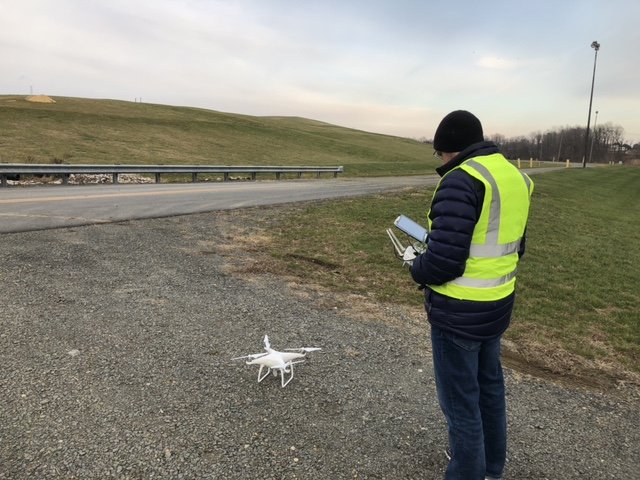Winter Weather Flying
16 Tips for Flying Drones in Cold Weather Conditions
Nearly every drone ad features people in bright sunshine wearing summer clothes. While this is ideal, it’s not reality for many solar drone pilots in the Northeast, Midwest, and even parts of Texas on a particularly cold winter day.
If you fly drones for solar surveys, knowing how to handle winter weather is an essential skill to ensure you can fly year-round.
Operating out of places like New York, New Jersey, Colorado and Utah, and having conducted many drone surveys in the cold and snow, the Scanifly team put together a guide on the key things you can do to navigate winter weather effectively as a solar drone pilot.
Here are some tips for protecting your drone when flying it in cold weather:
-
Set up the drone inside your vehicle: Unfold the propellers and turn on the controller while inside a warm vehicle.
Michael Thronson, a surveyor for SunCommon based in Vermont and New York puts his drone right on the seat. “The drone is my passenger,” he jokes. “I have heated seats so it keeps the drone warm throughout the day. If you don’t have heated seats, at least point the car vents towards the drone.”
-
Make your drone flight the first thing you do: As soon as the drone is set up, take it outside and do the survey. This minimizes the time that your drone is exposed to the cold.
-
Keep your flights as short as possible: Only fly to capture the photos you need for a survey. If you’re using point of interest (POI) flight mode to capture surveying images for Scanifly, this process shouldn’t take more than about 15 minutes.
-
Adjust the battery settings: Bring the minimum battery charge setting down to 15%.
-
Adjust drone settings for ideal capture: Adjust the aperture and shutter speed to avoid overexposure from snow. You can also turn on the overexposure warning feature so the drone alerts you automatically.
-
Remediate problems quickly: If you notice a possible overexposure, keep the autofocus and white balance settings to automatic. However, adjust ISO to 100, shutter speed to 1/320, and further adjust the aperture so you have a darker image.
-
Charge your battery right before the flight: If you charge your batteries far in advance but don’t use them, the battery life can dwindle.
-
Consider a hard-shell case: A hard-shell case can help keep the drone warm and protected.
Protecting your phone and drone controller
Your drone is important, but you need both your phone and controller to work properly as well.
-
Keep it in a protective casing: Use a thicker case to keep the phone protected, connecting it to the drone controller via USB cable.
-
Use a tablet holder: Larger tablet holders will help you see your phone more easily in inclement weather and ensure that you can use it even with cold fingers.
-
Keep everything warm until you need it: While most drone controllers and phones will be ok in the cold, don’t push it. Keep it warm - in your car or in an insulated hardshell case - until it’s time for take off.
Thronson shared that he actually has more issues with his devices than his drone. "I always keep a peripheral battery connected to my iPad because it dies quickly. Without it, I can’t fly.” Michael tries to keep his ipad tucked into his jacket when not flying and only brings it out at the very last minute.
Protecting Yourself
Your health and safety are the absolute most important part of this operation. Michael noted that this is the most important part. "Keep yourself warm because you're not moving around much when flying". Michael always wears a large coat, mittens, boots, and often keeps one hand warm. "I still always have one hand though to fly" he concluded.
Here are some tips for protecting yourself when flying drones in cold weather:

-
Wear warm gloves: Thinner materials can help keep your hands warm while also giving you the necessary dexterity to use the controller.
-
If you can, fly the drone from inside your vehicle: This may not work in tight settings where you need full visibility, but if you’re in an open field you can likely fly the drone from your vehicle to stay warm.
-
Use high-quality landing pads for the drone: Try an insulated electrician’s pad or a drone-specific landing pad. This is great for the drone itself, but it also helps avoid any issues or errors that could result in you being harmed by the drone when landing.
-
Don’t fight against huge snowfall: If there’s a lot of snow on the roof causing poor visibility, don’t fight it. Redflag the site to visit again when the snow is gone (or least there’s less of it) so you can safely survey.
Drones can fly in almost all weather if you’re careful
While flying on a warm day might be your preferred method, drones are capable and adaptable machines that can operate in almost any weather. When it comes to cold weather and snow, the key is to plan ahead and focus on staying warm as much as you (and the drone) can.
Flying in winter is not the most fun part of the job, but it doesn’t need to be painful either. If you prepare in advance and take steps to mitigate any problems, flying a drone in winter weather will often end up being the same kind of work as any other weather.

